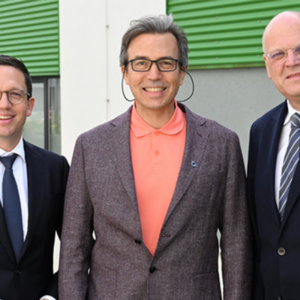31.08.2024
Authors Bornhorst D, Hejjaji AV, Steuter L, Woodhead NM, Maier P, Gentile A, Alhajkadour A, Santis Larrain O, Weber M, Kikhi K, Guenther S, Huisken J, Tamplin OJ, Stainier DYR, Gunawan F Journal Nature Communications Citation Nat Commun. 2024 Aug 31;15(1):7589. Abstract The contribution of endocardial cells (EdCs) to the
30.08.2024
First “Lower Saxony Professorship” goes to the University Medical Center Göttingen
MBExC member Prof. Dr. Urs Valentin Nägerl, Director of the Institute of Anatomy and Cell Biology at the University Medical Center Göttingen (UMG) since 1 September 2024, has been awarded the first “Lower Saxony Professorship”. The funding line of the Lower Saxony Ministry of Science and Culture and the Volkswagen
29.08.2024
Blood-derived microRNAs are related to cognitive domains in the general population
Authors Melas K, Talevi V, Imtiaz MA, Etteldorf R, Estrada S, Krüger DM, Pena-Centeno T, Aziz NA, Fischer A, Breteler MMB Journal Alzheimer’s & Dementia Citation Alzheimers Dement. 2024 Aug 29. Abstract Introduction: Blood-derived microRNAs (miRNAs) are potential candidates for detecting and preventing subclinical cognitive dysfunction. However, replication of previous
29.08.2024
Bleaching protection and axial sectioning in fluorescence nanoscopy through two-photon activation at 515 nm
Authors Bredfeldt JE, Oracz J, Kiszka KA, Moosmayer T, Weber M, Sahl SJ, Hell SW Journal Nature Communications Citation Nat Commun. 2024 Aug 29;15(1):7472. Abstract Activation of caged fluorophores in microscopy has mostly relied on the absorption of a single ultraviolet (UV) photon of ≲400 nm wavelength or on the simultaneous
29.08.2024
PRDM16-DT is a novel lncRNA that regulates astrocyte function in Alzheimer’s disease
Authors Schröder S, Fuchs U, Gisa V, Pena T, Krüger DM, Hempel N, Burkhardt S, Salinas G, Schütz AL, Delalle I, Sananbenesi F, Fischer A Journal Acta Neuropahologica Citation Acta Neuropathol. 2024 Aug 29;148(1):32. Abstract Astrocytes provide crucial support for neurons, contributing to synaptogenesis, synaptic maintenance, and neurotransmitter recycling. Under
27.08.2024
The amyloid oligomer modulator anle138b has disease modifying effects in a human IAPP transgenic mouse model of type 2 diabetes mellitus (hIAPP Ob/Ob mice)
Authors Albariqi MMA, Baauw SMG, Fens SPJP, Versteeg S, Ryazanov S, Leonov A, Willemen HLDM, Stathonikos N, Seychell RM, El Saghir A, Gerritsen B, Khemtemourian L, Vassallo N, Giese A, Eijkelkamp N, Griesinger C, Höppener JWM Journal BioRxiv Citation bioRxiv 2024.08.27.609850. Abstract Cytotoxic aggregates of human islet amyloid polypeptide (hIAPP)
24.08.2024
TOM-TIM23 supercomplex formation
Authors Jain N, Gomkale R, Rehling P Journal Methods in Enzymology Citation Methods Enzymol. 2024;707:3-22. Abstract Mitochondria import the vast majority of proteins from the cytosol. Protein translocation machineries in outer and inner membranes facilitate precursor recognition and transport. Most mitochondrial proteins utilize N-terminal presequences as targeting signals that eventually
22.08.2024
Optical control of pH via chromoselective photodosimetry
Authors Chaudhuri A, Eijsink LE, Simeth NA Journal Chemical Communications (Cambridge) Citation Chem Commun (Camb). 2024 Aug 22. Abstract The dynamic regulation of pH via an external stimulus is an attractive technique to gate chemical transformations. Applying photons of different energy, we preferentially address either a photoacid or a photobase
22.08.2024
Ceremonial Opening of the Heart & Brain Center Göttingen
Ceremonial opening of the new Heart & Brain Center Göttingen (HBCG) of the University Medical Center Göttingen (UMG) on 22 August 2024. The federal government and the state of Lower Saxony are investing around 38 million euros in the new building. Research groups work in an interdisciplinary manner on cutting-edge
22.08.2024
Protein folding helpers in their natural environment
Scientists from Martinsried and Göttingen have analyzed protein folding helpers, so-called chaperonin complexes, in their natural environment using cryo-electron tomography. Cryo-electron tomography, or cryo-ET for short, can be used to visualize and analyze cellular structures in their natural environment. Researchers at the Max Planck Institute of Biochemistry (MPIB) in





